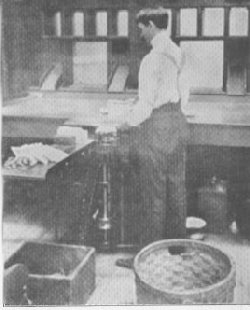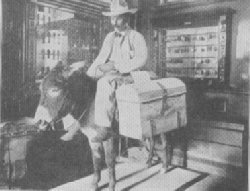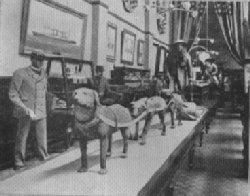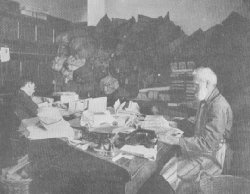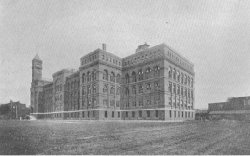The cost of running the department for one year is nearly $110,000,000, and the receipts are about as much—for, in spite of the excellent organization of the department, the government is so liberal in the matter of second-class postage that expenses are not always met by receipts. To indicate the enormous extent of this business, it may be said that, every minute of the day, about 12,000 messages are delivered. The service is constantly growing and these figures will soon be eclipsed. The department handles about 7,000,000,000 pieces of mail annually, of which about one third are letters. This growth is in marked contrast with the meager showing of the department under Timothy Pickering, the first postmaster general. In his regime the work of a quarter of a year was represented by $63,000 in receipts and expenditures—an amount now excelled every five hours of the day. Little could one foresee in this simple beginning the smoothly-working system of to-day, with its lightning mail trains, its free rural and city deliveries, its special deliveries that rival the telegraph, and its gigantic money-order department. This great branch of the government business machinery is divided into four sub-departments, each under the supervision of an assistant postmaster general. These are: first, the branch that has charge of the administration of the postoffices, carriers and clerical force and the actual management of the general work of the offices. This department expends annually about $40,000,000; second, the branch for the transportation of the mails, which contracts with the railway companies for service, etc., and costs about $35,000,000 a year to operate; third, the branch which keeps the financial accounts and furnishes stamps, postal cards, etc.; fourth, the branch which appoints over 70,000 postmasters and directs the force of inspectors. In addition, there is an auditing bureau under the Treasury Department, employing over 500 clerks, which scrutinizes and audits all post-office accounts. The expenses and receipts of the numerous post-offices differ greatly, the New York receipts being tens of millions of dollars, with a great percentage of profit, while many of the small country offices do not sell $25 worth of stamps a year. The salaries of postmasters vary with their positions. Those who are appointed by the President, about 4,000 in number, receive not less than $1,000 yearly, while the fourth-class offices, in which salaries are less than $1,000, number over 70,000 and are filled by appointment of the postmaster general. Several departments of the service deserve particular mention. The free city delivery system is one of these, employing over 140,000 carriers, at an annual expense of more than $14,000,000. This accomplishes the delivery of mail to the door of every resident of the larger cities, without the least inconvenience. The marine postal service on the great lakes involves the delivery of mail sent to and from sailors on moving vessels. The smoothness of the operation of this branch of the service can be best noticed at the mouth of the Detroit river, where during eight months of the year vessels pass every three and a half minutes of the day and night. This great fleet has a perfect mail service. All vessels are met and mail is collected and delivered, with the vessels in full motion. Water-tight bags are used for this purpose, as a safeguard in case the collector should have a "spill." The letters are stamped on the back with the name of the vessel to which they are destined.
Most important of all branches of the service is the railway postoffice, which started in 1864, now employs about 10,000 men, and annually covers nearly 300,000,000 miles on about 174,000 miles of track. The mail handled by this branch of the service has of late doubled nearly every six years. In 1884, the mail distributed in railway postoffices amounted to 4,519,661,900; in 1898 12,225,706,220; and at present, about 15,000,000,000 pieces are handled. So efficient is this service that mails are carried, sorted, pouched and delivered to every point desired, without delay at the distributing point. The work is so exacting that clerks must be well versed in its requirements. Every office in a territory must be known to every clerk, and no forgetfulness or error in placing in the mail bag is permitted. Extremely stringent examinations are held for applicants for positions in the railway mail service, and so well has the clerk learned his lesson, that on an average, only one error is made in the sorting and delivery of 10,428 pieces of mail. Time is such a factor in the railway mail service that new trains are being constantly scheduled by the railway companies, and all sorts of devices are used to secure the rapid transit of mails. Now, the fast mail train crosses the continent four hours ahead of any passenger trains, and often between Chicago and Omaha, a speed of from 80 to 90 miles an hour is attained. In this rapid race many smaller stations must necessarily be swiftly passed. The mail received by the railway mail cars at such points is taken on by an automatic device like a crooked arm, projecting from the open door of the cars, which, by pressure of a lever, will reach out, seize a bag of mail fastened to a post on the railway platform, and hurl it inside the car. Mail for these stations is dropped off generally by hand. The railway branch of the postal service is dangerous, as many as 75 employes having been killed and over 1,000 injured, in a single year. In this branch of the service, in order to save time in the final delivery of mail at its destination in the large cities, men well informed as to these cities are on board the fast trains, who sort the mail into the pouches so well, that the latter may be taken directly from the train to the numerous sub-stations in the cities. It may well be imagined that a great many bags are necessary in the mail service. The great trend of bags is from the East westward, and from great business centers toward the country districts. Every year, nearly a million and a half bags are repaired and put into service, most of them through the New York postoffice. Naturally, some postoffices will accumulate more bags than they can use for return mails. Cincinnati and St. Louis are made distributing points from which a call for from 5,000 to 20,000 bags may be supplied at almost any time. Bags are supplied by contract. All sorts of them are in use, and of course the greatest demand is for new ones. The greatest flow of bags, after they get into service, is from the offices at Washington, Baltimore, New York, Chicago, Boston and Philadelphia. The period of greatest activity is during the Christmas and New Year holidays, when business firms and individuals are sending out great quantities of packages by mail. The bags containing these gradually return to the central stations late in January, and once more flow out in May, when the spring advertising season sets in. Of the numerous kinds of bags, there must be those for the mountain carriers, the runner on snowshoes, knapsacks, and bags for the Alaskan dog teams, and saddle bags for the pony express. One of the recent odd bags devised is a perforated affair, for transporting live queen bees to the islands of the Pacific.
The money-order division of the postoffice department is one of the greatest clearing houses in the world, and easily rivals the foremost banks. This is one of the greatest sources of convenience to the public. The system is so complete that money may be sent by it almost to any point in the world. By means of the international money-order system, money is exchanged between different countries. So great is the business of this division, that money orders numbering over 30,000,000 are issued in a year for amounts aggregating about $210,000,000. This work necessitates the employment of 350 people who do nothing but add up columns of figures all day.
Package carrying has grown to a great volume. Even the express companies are meeting serious competition at the hands of the postoffice department. In the western hemisphere, at present, nearly a score of countries and colonies can be reached by package post, which will carry merchandise, etc., to the weight of 11 pounds.
1This
machine is a late invention, and is operated by electricity. It cancels from three to five thousand letters a minute. 2Opening dead letter packages in the Dead Letter Office of the Post Office Department. All kins of curious merchandise and periodicals, and een infernal machines, are received here and opened. When a large amount of merchandise is collected, it is placed in blind packages and sold at auction. UNDERSIRABLE IMMIGRANTS AND STATISTICS OF IMMIGRATION |
